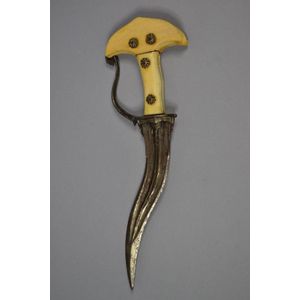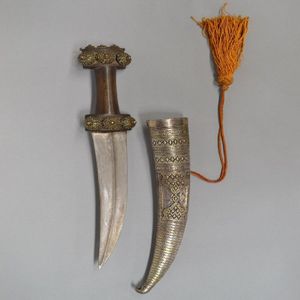18th/19th Century Indian Khanjarli with Gold Overlay and Ivory
You must be a subscriber, and be logged in to view price and dealer details.
Subscribe Now to view actual auction price for this item
When you subscribe, you have the option of setting the currency in which to display prices to $Au, $US, $NZ or Stg.
- Ivory - Ivory is a hard white material that comes from the tusks of elephants, mammoth, walrus and boar, or from the teeth of hippopotamus and whales. The ivory from the African elephant is the most prized source of ivory. Although the mammoth is extinct, tusks are still being unearthed in Russia and offered for sale.
Ivory has been used since the earliest times as a material for sculpture of small items, both in Europe and the east, principally China and Japan.
In Asia ivory has been carved for netsuke, seals, okimono, card cases, fan supports, animals and other figures and even as carved tusks.
In the last 200 years in Europe ivory has been used to carve figures, for elaborate tankards, snuff boxes, cane handles, embroidery and sewing accessories, in jewellery and as inlay on furniture. Its more practical uses include being used for billiard balls, buttons, and a veneers on the top of piano keys.
The use and trade of elephant ivory have become controversial because they have contributed to Due to the decline in elephant populations because of the trade in ivory, the Asian elephant was placed on Appendix One of the Convention on International Trade in Endangered Species (CITES), in 1975, and in January 1990, the African elephant was similarly listed. Under Appendix One, international trade in Asian or African elephant ivory between member countries is forbidden. Unlike trade in elephant tusks, trade in mammoth tusks is legal.
Since the invention of plastics, there have been many attempts to create an artificial ivory
This item has been included into following indexes:
Visually similar items

Indian khanjarli, 29 cm overall with 19 cm double edged double fullered recurved blade with pronounced central ridge and armour piercing tip. Steel mounted hilt with ivory grip scales set with silver foliate studs. (See 'Stone's Glossary' figure 445, numbe

Important large Balkan jambiya with scabbard. 395 mm overall with 240 mm curved double edged watered steel blade of good quality with pronounced central ridge. One piece horn hilt set with nine large silver studs. Wood lined scabbard of heavy silver with o

Important Indian jambiya with scabbard, 30.5 cm overall with 20 cm double edged double fullered blade of fine watered steel, the ricasso with gilt koftgari floral decoration on both faces. Steel mounted hilt with bone grip scales. Red cloth covered wooden

Rare pair of old Bhuj pesh kabz daggers with scabbards. Each 27.5 cm overall with 17.5 cm good quality recurved blade of strong T section. Steel mounted hilt with bone grip scales. Black leather covered wooden scabbard with fine silver chape. Complete with
